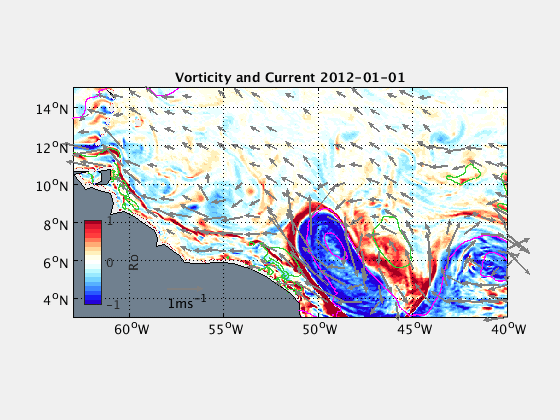NOAA CVP: Coupled ocean-atmosphere interaction mediated by ocean mesoscale eddies in the Northwestern Tropical Atlantic Ocean (2019-2022)
The primary goal of the ATOMIC experiment is to improve understanding of ocean-atmosphere interaction in the presence of energetic ocean mesoscale variability in the northwest tropical Atlantic. A particular focus is on documenting the role of ocean mesoscale eddies and fronts in the surface fluxes of momentum, heat, and freshwater, and examining how the eddy-mediated air-sea fluxes relate to ocean boundary layer mixing, low-level clouds, and regional climate.
We hypothesize that the mesoscale variations in the air-sea flux at sub-monthly and sub-100-200 km scales represent an essential part of the coupled boundary layer physics in the study region. However, spatially distributed measurements and dedicated high-resolution coupled model simulations do not coexist as yet to describe and quantify the eddy-mediated air-sea flux variability and its impacts. We propose a hierarchy of model simulations in tandem with other observational studies in support of the ATOMIC/EUREC4A to improve our process-level understanding of the physics of, and the factors influencing, the mesoscale variations in the air-sea fluxes. It will also provide a unique opportunity to explore their upscaling effects on the trade wind cumuli and large-scale regional climate.
Our simulations will be based on the 3-D SCOAR regional coupled model (WRF-ROMS) and a 1-D implementation of the 3-D ocean model with various mixing schemes. The 1-D model simulations will primarily investigate the effects of background stratification modulated by mesoscale eddies and the resulting changes in the surface waves and air-sea fluxes on the ocean mixing and dissipation rate. The 3-D SCOAR model simulations will be run at 3 km resolutions both in the atmosphere and the ocean to explicitly resolve cumulus convection and ocean mesoscale variability. These fine-scale ocean and atmospheric fields will be coupled through the COARE bulk flux algorithm including any changes that may arise from other proposed ATOMIC research. The spatial-scale dependent effects of mesoscale eddies on the air-sea fluxes will be examined by our novel coupling technique, which filters out imprints of mesoscale eddies (SST and current) in surface fluxes. Finally, ensembles of 3- D coupled model simulations will be conducted with one-way and two-way nesting to explore the upscaling effects on the regional-scale ocean and atmospheric boundary layers.
Coupled model simulations at the proposed fine spatial and temporal scales have not been conducted previously alongside observations with sufficient spatial and temporal detail to constrain and validate the model simulations. The proposed model simulations will allow for air-sea coupling at sub- monthly scales and sub-100-200 km scales to be quantified for the first time in the region. To guide the field experiments, various virtual sampling arrays with online budget calculations will be trialed to assess the efficacy for proposed sampling strategies. We expect that other science questions and new observational plans if they emerge can be addressed by our unique and flexible modeling plan.
Improved physical understanding of mesoscale and frontal-scale ocean-atmosphere interactions is currently of significant interest to the science community. The proposed research will help improve climate model simulations at such scales and benefit the general public by helping to provide more reliable regional-scale predictions. The project will support a postdoc in physical oceanography and meteorology and offer various opportunities to mentor students from historically under-represented groups in the sciences through WHOI and other REU programs designed to promote diversity.
Hyodae Seo, Carol Anne Clayson, César Sauvage
